1. Five Examples of LINE in textile design
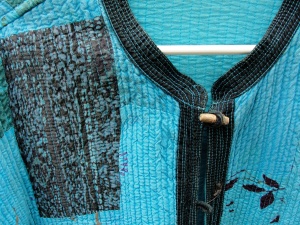
The use of line in this jacket from Rajasthan (northwest India) is a dominant visual feature. Each of the three panels (jacket, patch, and collar) is stitched with continuous lines of thread. These details add a depth to each of these panels and draw the eye to the hand workmanship of stitching and to the overall design. The stitching also adds a weight to the textile, which helps it function as a heavier-weighted garment, much like quilting adds to the structural weight of pieced cotton quilts. Because of the detailed stitched lines of thread, the textile is perfect for a jacket that holds its shape and feels warmer to wear. The use of the natural shapes of leaves acts as an organic counterpoint to the otherwise symmetrical and asymmetrical patterning of stitched lines. Wearing a jacket like this is akin to wearing a piece of art, therefore the rest of the outfit should be downplayed to avoid any distraction from the elaborate design of this singular piece. [Jacket in author’s collection].
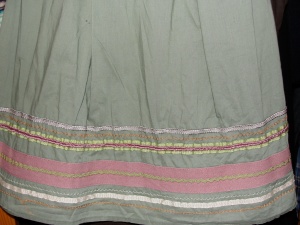
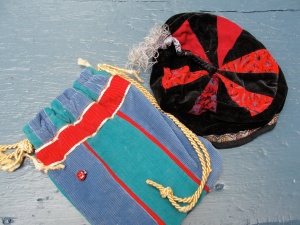 Line: Horizontal; Line: Corduroy quadrants; Radiating triangles
Line: Horizontal; Line: Corduroy quadrants; Radiating triangles
The horizontal lines of contrasting rickrack and ribbon banding on this skirt work to add interest. This textile is very appropriate for this skirt as it is a tough and very durable cotton fabric and the embellishment of the banding evokes a nostalgia for an earlier time when it was common for people to decorate their garments. The lines of banding themselves give interest in their varied widths, colours and textures, yet all still in the muted tones of the period. Here, in this skirt, the advantage is to add interest to the embellishment of an otherwise plain skirt and is best illustrated by dancing in it, perhaps at a summer picnic or a barn dance. Choosing a top to complete the ensemble is done best by wearing a top in one of the colours in the banding with an optional belting in one of the other colours. Choosing other types of lines (curved or jagged) for a top or hosiery would be a distraction from the muted embellishment of the skirt.
The use of colourful corduroy panels and use of ribbon and banding give a fun and youthful energy to this bag for kicking stones. It was quite common in years past to find kicking stones on paths and roadways that, after kicking along for the mile walk to the swimming hole or to the neighbouring farm, a person becomes attached to. What better way to collect these stones for a child then to have their own bag that is easily carried or easily hung on a peg for the next happy walk. The choice of corduroy is a sturdy material and children love to touch the fabric. The colourful lines of banding and panels and the special details of gold ribbon make this a keepsake. The ladybug pin is an example of a fun embellishment. Because the lines of banding separate the panels, the substitution of flowered or printed fabrics in lieu of the solid corduroy would not be a problem as long as the colours chosen work with the new piece.
The radiating triangles of the child’s Tibetan hat are perfect for little ones to wear. The deep red triangles of printed velvet contrast to the negative space suggested by the black velvet triangles. Because these hats are usually worn by children, they also have delightful interest for adults as they can easily see the radiating triangles from above. The side panel has a metallic embroidered banding which uses line effectively in drawing interest to the unique hat design. Obviously, radiating triangles would not a satisfactory choice to the front panel of an dress or top, especially to someone who is heavier. Generally we want to draw the eye to the positives and away from what we may see as the “in process” aspect of ourselves.
Line: Curvilinear: The lines in this dress give interest to a garment that is fairly boxy in shape. The lines are curving and in some areas jagged. There are some minor embellishment of jewels in the right top part of the dress that mirror the colours in the rest of the garment. This textile is perfect for a summer dress that is colourful, youthful and adaptable to afternoon or evening events. The use of curving or jagged lines in this dress are not overwhelming, but they could be if chosen in larger line patterns and colours that are are more jarring with each other. That kind of textile could look great if worn by a thinner person but could be too attention-grabbing for someone who “has more to hide”.
Line- vertical
The long thin lines of this denim fabric are a good design choice for this chair cushion. Preparing the fabric for cutting and sewing is imperative to make sure that the lines are straight on the bias, otherwise the lines will look twisted, even though the seams may match up. This sizing of the fabric is even more important if piping is chosen to add interest to the seams. There is no point in adding interest to embellishment if the area is not visually precise. The choice in this fabric stems from an interest in French linens, especially that evoke the countryside and the ticking fabrics of times past. Adding the precise navy line of piping gives the textile a more sophisticated touch; hopefully no-one will confuse it with a train conductor’s overalls!
[All photos above from the author’s collection].
2. Five examples of PATTERN in textile design
These dirt bike gloves belong to my son and show interesting pattern choices by the manufacturer. Firstly, my son loves green and he really likes the bold pattern of the green spandex and the slits of green on each of the fingers. The green is used again on the cuff in the choice of green line gradients as well as the rays of green that radiate out from the brand name. Lime green works well with black and the patterns of black and green give a feeling of energy, excitement and forward-thinking design. A perfect choice of pattern for a teenager to encourage wearing safety gear while doing a fairly dangerous sport. As a mother who is often faced with the one sock or one glove dilemma, having them made out of bright solid orange might have been a better design choice, but a teenager would probably not agree.
The repeating flower pattern of this black lace blouse (seen here held in front of a window) is a perfect choice for a more formal occasion. The lace is delicate and feminine as are the tendrils of flower stems and petals. Seen against the skin, the fabric suggests a certain erotic quality but is downplayed by revealing only the arms and decollete. The blouse, if worn with more revealing undergarments or nothing underneath, would appear inappropriate for wearing in public, but are lovely if worn for private occasion.
The jacket from Rajasthan here surfaces as a clever use of pattern. The patterns of framing the neckline, front, bottom hem and pockets in black linear fabric is effective for overall framing of the artwork found on the body of the garment itself. The panels of pieced traditional fabric designs are imperfectly mirrored to produce uniformity in colour and sizing but difference in placement. This keeps the overall design more interesting with a nod to modern geometrical arrangement. The black details as well as the continuous hand stitching over every piece of fabric help pull the various features together. These elements create a distinctive garment. Without the black details pulling it together, I think the overall result would be akin to wearing a favourite old crazy quilt. I love the precision of the black and the punctuation of the wooden togs that keep the jacket smart looking. For the days when a person might not be quite so brave in colour and design or have another garment to work with, the jacket is reversible, revealing the pure blue fabric with only the details of stitching as embellishment. Definitely a happy-day jacket!
The black and white houndstooth pattern on the left is a great go-to jumper for winter and looks great with a black turtleneck with a splash of bright red or yellow in an accessory. The repeating pattern is small-scale, simple, yet of visual interest. Large patterns of this pattern are best used for a tailored jacket or hat but tend to be too much, visually, for a dress. A person shouldn’t dress as an optical illusion. Or should they?
The teal and gold repeating pattern of this picnic basket liner/ placemat is made of quilting cotton. It’s almost a honeycomb pattern and is a happy, youthful mod addition to a table setting. I use this for my teenage son who has absolved himself from younger settings of flowers and lace. Boys also tend to gravitate to geometrical designs and offer a more abstract yet “engineered” look. I can’t imagine a blouse made from this fabric but I could almost imagine a very fitted boxy 1950’s wool dress with a gold pillbox hat. Cat frames anyone? Definitely white ones would be de rigueur.
3. Five examples of TEXTURE in textile design
While this Italian farm dress is more noticeable for its pattern, I chose to include it here for texture. I have worn this dress for years so have no idea what the fabric is but it must have some polyester in it (I think) as it feels slippery, cool, almost a seersucker but not, and it dries quickly. A perfect dress for pairing with a light camisole or tank top under the straps and wearing around the gardens, throwing over the bathing suit or going for walks on the country roads. The long length tends to confuse the black flies and mosquitoes. A great fabric and texture for hot summer days.
The texture of wool and cotton can not be beat for floor coverings, especially in the colder months. The thicker the weave the better to allow more protection from drafts and wear. The texture feels wonderful to the feet and knowing that the fibres are natural bring an added pleasure. I regard those delightful-feeling cuddle blankets of acrylic for babies with suspicion. I’m sure I’ve heard of the fibres from those fabrics being breathed into tiny lungs. The long-term appreciation for the textures of wool and cotton should be encouraged for young people despite their perception that wool is always itchy and both considered outdated and difficult to care for. The small wool carpet on the left is woven very tightly and therefore has a hard texture when used for carpeting. The horse blanket of cotton on the right has a much softer texture as the weave is a little looser, the cotton threads thicker and because of its size (3 feet by 6 feet), it can be washed easily in the washing machine. This makes the texture even softer as time goes on.
The hammock that my young grand-nephew is enjoying is made of nylon cotton. The benefit of this material is that is softer than pure nylon but is longer lasting than a hammock made of just cotton. It is also cheaper. Texture is important when you are laying in a hammock as you tend to be wearing shorts and lighter clothing so the feel against your skin is very important. This is even more important for children who have more delicate skin than the more seasoned among us. Traditionally hammocks made in Mexico came from the Yucatan peninsula and families were famous for their centuries-old traditions of weaving them. The best were always made from the best cotton and the nylon ones made by others for the tourist markets. These traditional ones also came in the “matrimonial” size and was the bed for newlyweds. The best cotton and the best weaves for soft texture yet great and long-standing strength were crucial. La basura, or the cheap ones, have changed this favoured bed of the tropics
The baby blanket. Who doesn’t respond well to the soft feel of well-washed cotton in a baby blanket. These are soft to the skin, easily cared for and the texture can be improved upon by higher thread counts, organic cotton or the blending of silks or bamboos into the weaves. These textures often take longer to dry than the synthetics but hanging them in the sun (or as Maritimers do- hanging them until they’re frozen sheets in winter) bring a softness to the fibres and a freshness to the cloth that delights our noses for the rest of our lives.
Two sources of interest that could be used for further instruction on the elements of design:
Utah State University Extension Services have a great site for learning about design:
Click to access FC_Clothing&Textiles_2012-05pr.pdf
Color and Composition for the Creative Quilter. Masopust, Katie Pasquini and Brett Barker. Lafayette, California: C & T Publishing, 2005.
Activity for FST-7 Textiles:
A.
Have students collect various samples of textures of textiles, make a list of these,
put samples into paper bags with the list hidden and separate. Have students take turns
with each other to identify how each sample feels (make a list of possibilities so students have the language) and try to identify what the textile might be.
B.
Have a local quilter come for a visit and students use their templates of composition that they make to use with fabric swatches to organize the fabrics in terms of their patterns. (The quilting book above uses a nine-patch of compositions template for the various patterns: vertical, horizontal, circular, diagonal, radiating, grid, framed/border, symmetrical and asymmetrical). Students would have lots of fun and the opportunity to problem-solve as they discuss and sort for pattern.
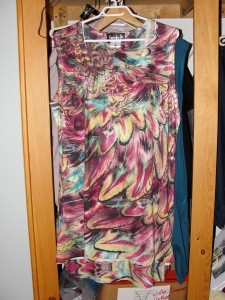
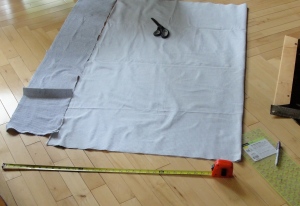
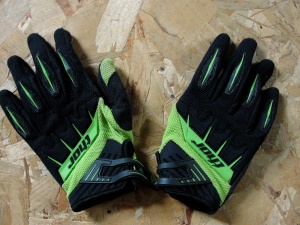
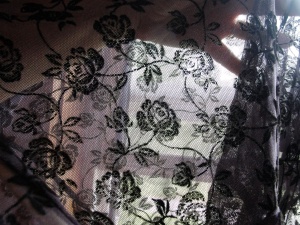
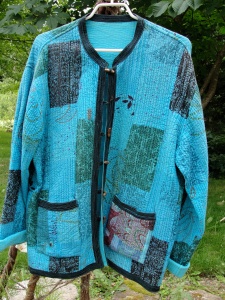
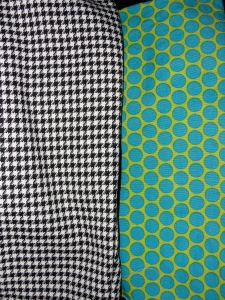
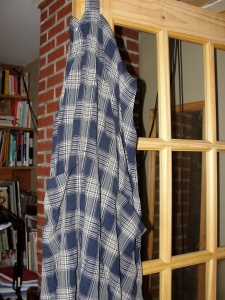
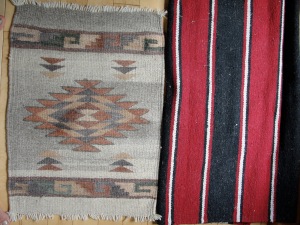
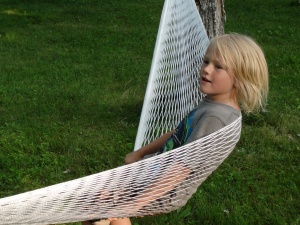
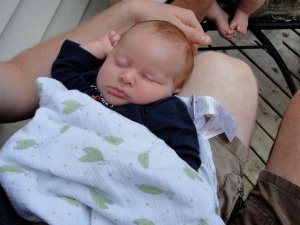
HI Brenda!
I love your pictures and the global flavour you bring to your blog. I especially appreciated the emphasis you put on the human side of using these items. You remind me that this isn’t just theory: it’s a way to describe how we live and interact with each other.
Heather
LikeLike
Hey Heather: How nice to get your feedback. I’m glad that you enjoyed it. Sometimes I feel like I have my tongue firmly in my cheek or that I DO GO ON. It’s kind of fun though, to write.
LikeLike
Superb photo essay! Understanding something of the politics and environmental impact of textile production is an integral aspect of textile arts education. I am glad you included it in your posting.
LikeLike
Thanks for the positive feedback, Cathy. I really had fun doing this project.
LikeLike